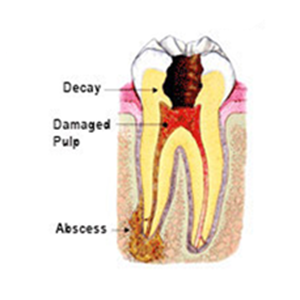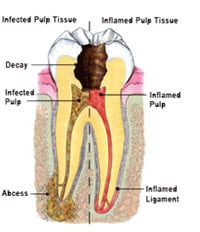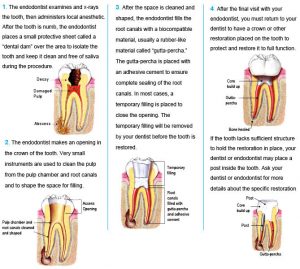We specialize exclusively in the diagnosis & treatment of endodontic conditions.
1.

The endodontist examines and x-rays the tooth, then administers local anesthetic. After the tooth is numb, the endodontist places a small protective sheet called a “dental dam” over the area to isolate the took and keep it clean and free saliva during the procedure.
The endodontist makes an opening in the crown of the tooth. Very small instruments are used to clean the pulp frlom the pulp chamber and root canals and to shape the space for filling.
2.

3.

After the space is cleaned and shaped, the endodonist fills the root canals with a biocompatible material, usually a rubber-like material called “gutta-percha.”
The gutta-percha is placed with an adhesive cement to ensure complete sealing of the root canals. In most cases, a temporary filling is placed to close the opening. The temporary filling will be removed by your dentist before the tooth is restored.
After the final visit with your endodontist, you must return to your dentist to have a crown or other restoration placed on the tooth to protect and restore it to full function.
4.

5.

If the tooth lacks sufficient structure to hold the restoration in place, your dentist or endodontist may place a post inside the tooth. Ask your dentist or endodontist for more details about the specific restoration.




 “Endo” is the Greek word for “inside” and “odont” is Greek for tooth. To understand endodontic treatment, it helps to know something about the anatomy of the tooth. Inside the tooth, under the white enamel and a hard layer called the dentin, is a soft tissue called the pulp. The pulp contains blood vessels, nerves, and connective tissue and creates the surrounding hard tissues of the tooth during development.
“Endo” is the Greek word for “inside” and “odont” is Greek for tooth. To understand endodontic treatment, it helps to know something about the anatomy of the tooth. Inside the tooth, under the white enamel and a hard layer called the dentin, is a soft tissue called the pulp. The pulp contains blood vessels, nerves, and connective tissue and creates the surrounding hard tissues of the tooth during development. Endodontic treatment is necessary when the pulp becomes inflamed or infected. The inflammation or infection can have a variety of causes: deep decay, repeated dental procedures on the tooth, or a crack or chip in the tooth. In addition, a blow to a tooth may cause pulp damage even if the tooth has no visible chips or cracks. If pulp inflammation or infection is left untreated, it can cause pain or lead to an abscess. Signs of pulp damage include, pain, prolonged sensitivity to heat or cold, discoloration of the tooth, swelling and tenderness in the nearby gums. Sometimes, there are no symptoms.
Endodontic treatment is necessary when the pulp becomes inflamed or infected. The inflammation or infection can have a variety of causes: deep decay, repeated dental procedures on the tooth, or a crack or chip in the tooth. In addition, a blow to a tooth may cause pulp damage even if the tooth has no visible chips or cracks. If pulp inflammation or infection is left untreated, it can cause pain or lead to an abscess. Signs of pulp damage include, pain, prolonged sensitivity to heat or cold, discoloration of the tooth, swelling and tenderness in the nearby gums. Sometimes, there are no symptoms.